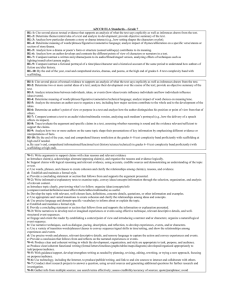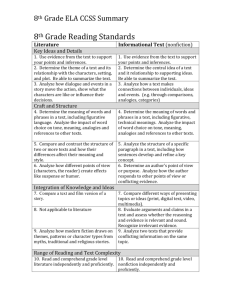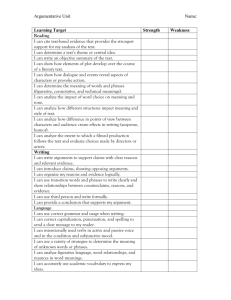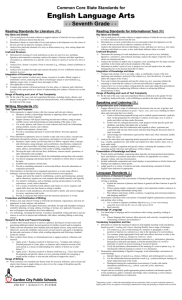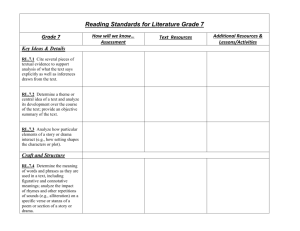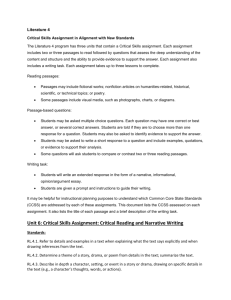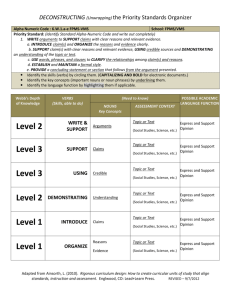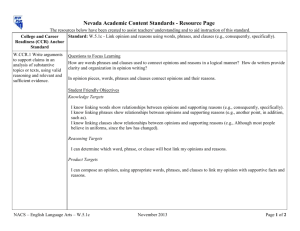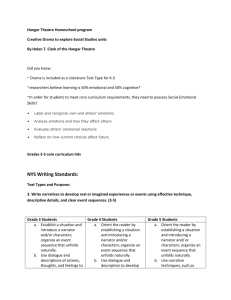7th Grade Common Core Standards
advertisement
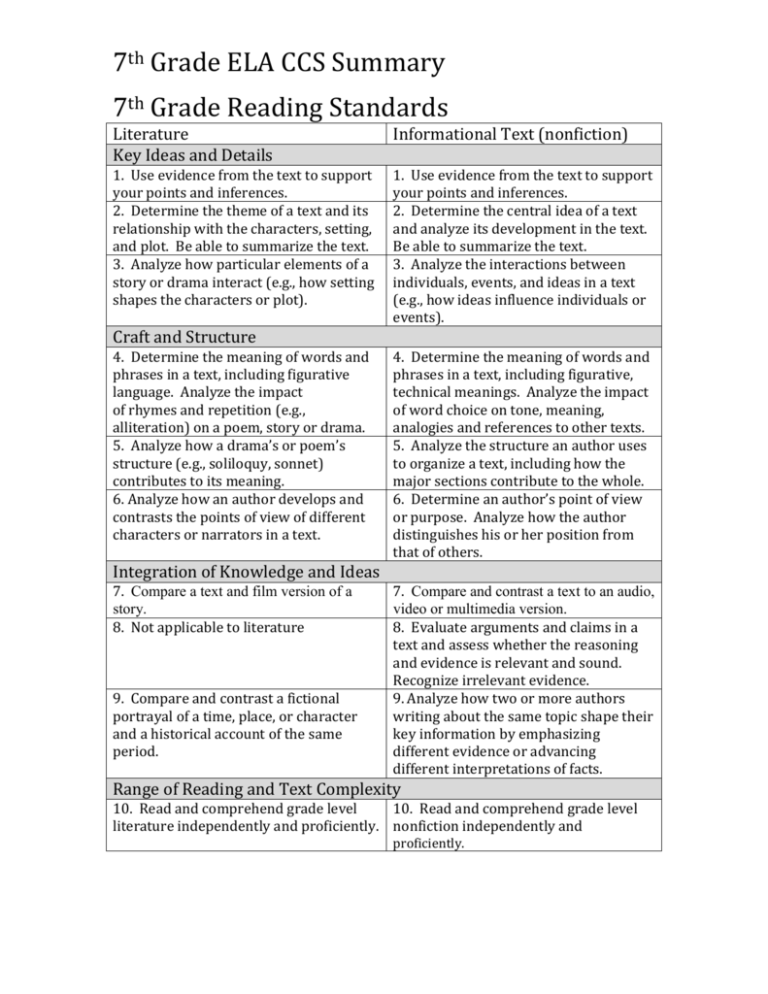
7th Grade ELA CCS Summary 7th Grade Reading Standards Literature Key Ideas and Details Informational Text (nonfiction) 1. Use evidence from the text to support your points and inferences. 2. Determine the theme of a text and its relationship with the characters, setting, and plot. Be able to summarize the text. 3. Analyze how particular elements of a story or drama interact (e.g., how setting shapes the characters or plot). 1. Use evidence from the text to support your points and inferences. 2. Determine the central idea of a text and analyze its development in the text. Be able to summarize the text. 3. Analyze the interactions between individuals, events, and ideas in a text (e.g., how ideas influence individuals or events). Craft and Structure 4. Determine the meaning of words and phrases in a text, including figurative language. Analyze the impact of rhymes and repetition (e.g., alliteration) on a poem, story or drama. 5. Analyze how a drama’s or poem’s structure (e.g., soliloquy, sonnet) contributes to its meaning. 6. Analyze how an author develops and contrasts the points of view of different characters or narrators in a text. 4. Determine the meaning of words and phrases in a text, including figurative, technical meanings. Analyze the impact of word choice on tone, meaning, analogies and references to other texts. 5. Analyze the structure an author uses to organize a text, including how the major sections contribute to the whole. 6. Determine an author’s point of view or purpose. Analyze how the author distinguishes his or her position from that of others. Integration of Knowledge and Ideas 7. Compare a text and film version of a story. 8. Not applicable to literature 9. Compare and contrast a fictional portrayal of a time, place, or character and a historical account of the same period. 7. Compare and contrast a text to an audio, video or multimedia version. 8. Evaluate arguments and claims in a text and assess whether the reasoning and evidence is relevant and sound. Recognize irrelevant evidence. 9. Analyze how two or more authors writing about the same topic shape their key information by emphasizing different evidence or advancing different interpretations of facts. Range of Reading and Text Complexity 10. Read and comprehend grade level 10. Read and comprehend grade level literature independently and proficiently. nonfiction independently and proficiently. 7th Grade ELA CCS Summary 7th Grade Writing Standards Writing Text Type and Purposes 1. Write arguments to support claims using relevant evidence. a. Begin with an introduction b. Support arguments with relevant evidence from the text or accurate sources. c. Clarify the relationships between arguments and evidence. Linking statement d. Use a formal writing style. e. Provide a conclusion 2. Write informative/explanatory texts to examine a topic and convey ideas. a. Introduce a topic clearly, summarize arguments and organize ideas. b. Develop the topic with relevant, facts, definitions, details, quotes and examples. c. Use appropriate and varied transitions to connect paragraphs and ideas d. Use precise vocabulary e. Establish and maintain a formal style. f. Provide a conclusion. 3Write narratives to develop real or imagined experiences or events. a. Engage reader by establishing a context and point of view and introducing a narrator/characters; organize an event sequence that unfolds naturally and logically. b. Use different narrative techniques, ((dialogue, pacing, description, and reflection) c. Use a variety of transition words, phrases, and clauses. d. Use precise words and phrases, descriptive details, and sensory language. e. Provide a conclusion that follows from and reflects on the narrated experiences. Production & Distribution of Writing 4. Produce clear and coherent writing in which the development, organization, and style are appropriate to task, purpose, and audience. 5. Develop and strengthen writing as needed by planning, revising, editing, rewriting, or trying a new approach independently and/or with help from peers and adults. 6. Use technology, including the Internet, to produce and publish writing and present the relationships between information and ideas efficiently as well as to interact and collaborate with others. 7. Conduct short research projects to answer a focus questions drawing on several sources. 8. Gather relevant information from multiple print and digital sources. Use search terms effectively, assess the credibility and accuracy of each source, and quote or paraphrase the data following a standard format for citation. MLA Format 9. Draw evidence from literary or informational texts to support analysis, reflection, and research. Range of Writing 10. Write routinely over extended time frames (research, reflection, and revision) and shorter time frames (a single sitting or a day or two) 7th Grade ELA CCS Summary 7th Grade Language Standards Language 1. Demonstrate a command of standard English grammar and usage when writing or speaking. a. Explain the function of phrases and clauses. b. Choose among simple, compound, complex sentences to signal relationships between ideas. c. Place phrases and clauses within a sentence, correcting misplaced and dangling modifiers. 2. Demonstrate command of the conventions of standard English capitalization, punctuation, and spelling when writing. a. Use a comma to separate coordinate adjectives. b. Spell correctly. 3. Use knowledge of language and its conventions when writing, speaking, reading, or listening. a. Choose language that expresses ideas precisely and concisely, recognizing and eliminating wordiness and redundancy. 4. Determine or clarify the meaning of unknown and multiple-meaning words or phrases based on grade 7 reading and content, choosing flexibly from a range of strategies. a. Use context (e.g., the overall meaning of a sentence or paragraph; a word’s position or function in a sentence) as a clue to the meaning of a word or phrase. b. Use common, grade-appropriate Greek or Latin affixes and roots as clues to the meaning of a word (e.g., belligerent, bellicose, rebel). c. Consult general and specialized reference materials (e.g., dictionaries, glossaries, thesauruses), both print and digital, to find the pronunciation or meaning of a word d. Verify the preliminary determination of the meaning of a word or phrase (e.g., by checking the inferred meaning in context or in a dictionary) 5. Demonstrate understanding of figurative language, word relationships, and nuances in word meanings. a. Interpret figures of speech (e.g. literary, biblical, and mythological allusions) in context. b. Use the relationship between particular words (synonym/antonym, analogy) to better understand each of the words. c. Distinguish among the connotations (associations) of words with similar denotations (definitions) (e.g., refined, respectful, polite, diplomatic, condescending). 6. Acquire and use accurately grade-appropriate general academic and domainspecific words and phrases; gather vocabulary knowledge when considering a word or phrase important to comprehension or expression.
